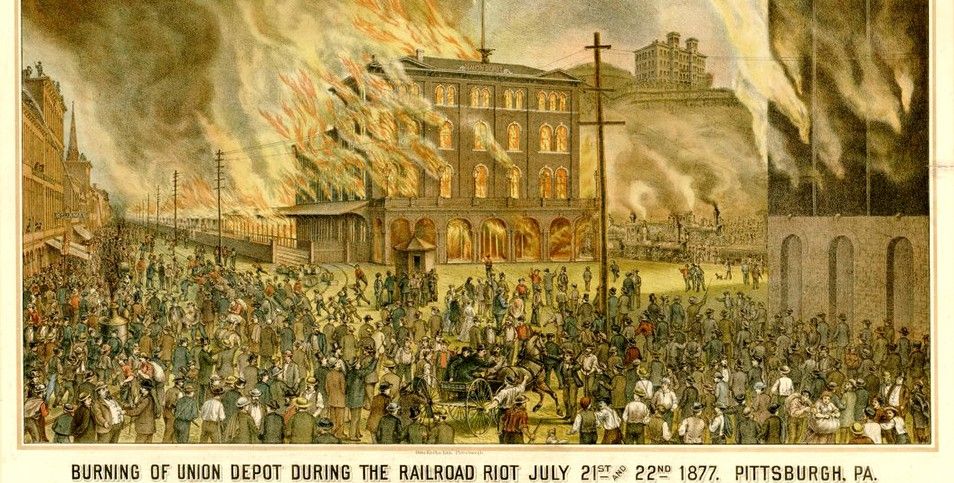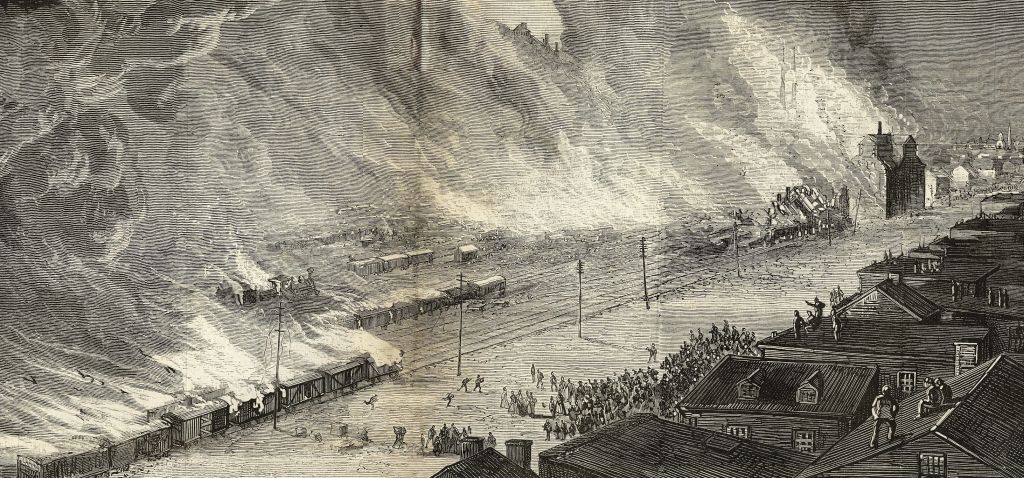The nation was torn apart by disastrous riots in a hundred cities and towns, with lasting results.
-
Spring 2020
Volume65Issue2

To the New York Tribune it was “an insurrection”; the St. Louis Republican called it “a labor revolution”; and the Pittsburgh Leader told its readers, “This may be the beginning of a great civil war in this country, between labor and capital.” The extraordinary events of July, 1877, did not quite add up to all that, but they certainly looked like a war while they were going on.
The Great Railroad War — or the Great Strike, as it came to be called when things had calmed down — was America’s first national labor uprising. It burst upon a hundred cities and towns and railroad crossings from New York to California: only New England and the Deep South were spared. Before it ended, more than a hundred persons had been killed and hundreds more injured; fully two thirds of the nation’s seventy-five thousand miles of railroad track had been affected; untold millions of dollars worth of railroad property had been burned, blown up, or torn apart. And, for the first time in U.S. history, federal troops in large numbers had been called out to crush civilian strikers.
Eighteen seventy-seven marked the fourth and worst year of the depression that followed the crash of ’73. Perhaps a million of the nation’s 4,500,000 non-farm workers were out of work. Trade unionism had virtually collapsed. Jobless men and their families choked city slums; thousands more roamed the countryside as tramps.
The railroads had sought to ride out the economic storm by cutting costs — including wages. The average trainman’s salary had already been reduced by 35 per cent since 1873. The men took it. They had little choice since there were no effective unions to fight for them and the countryside was full of unemployed men ready to take any job.
Then, four major railroads — the Pennsylvania, Erie, New York Central, and Baltimore & Ohio — announced a further wage cut of 10 per cent. With it came other economies that worsened the railroad man’s lot. Some lines began charging rent on the tiny track-side patches on which the trainmen’s shanties and kitchen gardens stood, and required crews to pay for return trips aboard trains they had just worked. (In one celebrated instance, a Lake Shore Line engineer was paid sixteen cents for operating one run, then charged a quarter to ride back home again.) And the railroads did all this to their men—and more—while continuing to pay out handsome dividends of 8 and 10 per cent to their investors.
It all finally became too much for the men to take, and on the hot morning of July 16 — the day the B & O pay cut was to take effect — crewmen at Martinsburg, West Virginia, swung down from their trains and refused to work, or to let anyone else board their trains to replace them. When militiamen tried to protect a cattle train run by strikebreakers as it inched its way through the angry strikers, there was some confused gunplay. A soldier was hit and a striker fell mortally wounded. Horrified, the crew and its uniformed escorts, many of whom openly sympathized with the railroad men, abandoned the train. No more freights moved through the Martinsburg yard for days — though here, as elsewhere, passenger trains were waved past by the strikers because they carried the U.S. mails.

Within hours (and without direction), the strike burned along the B & O line to Baltimore; over the next two weeks it would flare up all across the country: Scranton, Louisville, Chicago, Indianapolis, Cincinnati, Pittsburgh, Buffalo, St. Louis, San Francisco. In some places local grievances got mixed in with the strikers’ cause. In San Francisco, for example, mobs put Chinese neighborhoods to the torch, blaming white joblessness on the inhabitants’ willingness to work cheap: it took three thousand civilian vigilantes to restore order. In other places workers sympathetic to the trainmen rallied to their side.
A general strike gripped St. Louis: even newsboys refused to work. Coal miners walked off the job at a dozen points in Illinois and Pennsylvania. In Chicago, railroad men fought and marched alongside mill hands, lumberyard and stockyard workers, all chanting “Bread or Blood,” the dread slogan of the 1870 Paris commune: terrified businessmen patrolled residential neighborhoods with rifles. Everywhere, the strikers’ ranks were swollen by tramps, thugs seeking plunder, curious children, and teenagers who liked the excitement of hurling rocks and starting fires.
The strike hit Pittsburgh on July 19 with a special fury, in part because its citizens already hated the Pennsylvania Railroad for the economic damage its high freight rates had done to their city. Even the local militiamen supported the strike: no sooner were they called up than they stacked arms and joined the throng of strikers, millworkers, and onlookers who held the freight yard.
When six hundred fresh troops arrived from Philadelphia two days later, hauling cannon to show they meant business, they were surrounded by a crowd of perhaps six thousand. Under orders to clear the tracks, the troops fixed bayonets, but the crowd refused to budge and showered them with rocks and chunks of coal. The Philadelphians formed a hollow square and, when they heard a series of sharp explosions (pistol shots, perhaps, or firecrackers), began firing in all directions. The great crowd ran, leaving scores of wounded writhing on the ground. At least twenty persons died, including a woman and three children. The tracks were now open, but the soldiers could find no one willing to man the freights and retreated to the roundhouse for the night.
Outraged, the city’s populace swore revenge against the Philadelphians — and against the Pennsylvania Railroad. As night fell, armed strikers kept the troops pinned down; others systematically set the freight yard ablaze and rolled burning freight cars filled with whisky and other flammables downhill into the roundhouse. When it, too, was in flames, the soldiers shot their way out and fled the city for their lives. Behind them blazed more than twenty-one hundred freight cars—and a considerable section of the city.
Elsewhere, as well, state militiamen, mostly ill-trained and generally unenthusiastic about facing off against friends and neighbors, proved ineffective, and the governors of six states petitioned President Rutherford B. Hayes for federal troops to put down what they called “an insurrection.” (The governor of Maryland’s appeal had had special urgency; he wired it from the Baltimore depot where he and other dignitaries were besieged by fifteen hundred angry strikers and their allies.) Hayes responded swiftly, dispatching disciplined regulars to the worst trouble spots. A show of federal force was usually all that was needed to quiet things: the strikers’ quarrel was with the railroads, not with Washington.
By the twenty-eighth, the Great Strike was over. It had deeply shaken conservatives: John Hay thought it had shown the country “at the mercy of the mob,” while Jay Gould declared it marked the start of a “great social revolution” that would inevitably lead to monarchy. Several states enacted strong anti-conspiracy statutes that made union organizing more difficult. Many cities constructed thick-walled downtown armories just in case it all happened again. Though most railroad pay cuts were eventually rescinded as the economy improved, many strikers were jailed — and many more blacklisted.
The July uprising had failed because it had not been organized. But it had shown the workers their strength, and in the future they would learn how to use it. Years later, Samuel Gompers recalled its impact. “The railroad strike of 1877,” he wrote, “was the tocsin that sounded a ringing message of hope to us all.”

